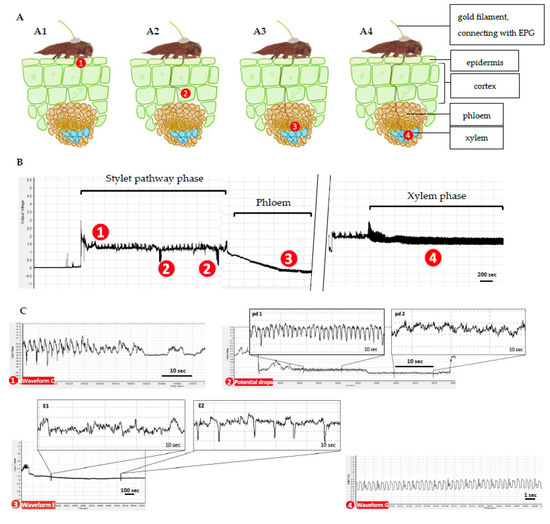昆虫はすでに米国17州に広がり、100万ドル規模のサルスベリ産業に脅威を与えています。Insect already spread to 17 U.S. states, threatening million-dollar crapemyrtle industry
2022-08-31 テキサス A&M大学
クラップマートルバークスケール虫は、20年足らずで17州に広がり、同名の病気を蔓延させ、グリーン産業に大きな脅威を与えています。
電気浸透探傷図(EPG)とカスタムソフトウェアを用いた独自のモニタリングシステムにより、研究チームは集中的な温室調査や費用のかかる労働をほぼ不要にすることができた。
クラペマートル・バーク・スケールは、長い口先で樹皮の隙間に入り込み、背中にワックスを塗っているので、樹皮に散布された殺虫剤をかわすことができる。その間、植物から樹液を吸い続け、植物の成長に必要な重要な栄養素を奪っていきます。
この害虫は、シカゴ・ハーディー・フィグからダイズまで、幅広い種類の植物を寄主にしており、治療法の必要性はさらに高まっている。
EPGモニタリングシステムを使用することで、研究チームは植物内の昆虫の探査活動を追跡することができた。その結果、昆虫と植物の相互作用についてより詳しく知ることができ、害虫駆除の可能性についてより深く理解することができました。また、EPG波形から、クラップマートル・バークスケール昆虫が植物から抽出する栄養分を観察することができた。
研究チームは、EPGと研究者が開発したソフトウェアシステムを使って、500メガバイトを超える生データから各EPG波形の周波数と相対振幅を数秒で計算することができた。
<関連情報>
- https://agrilifetoday.tamu.edu/2022/08/31/crapemyrtle-bark-scale/
- https://www.mdpi.com/2075-4450/13/6/495
電気浸透探傷法によるリアルタイム摂食行動モニタリングにより、宿主植物がサクラクレパス(半翅目:エリオックス科)に対して感受性があることを迅速に明らかにした。 Real-Time Feeding Behavior Monitoring by Electrical Penetration Graph Rapidly Reveals Host Plant Susceptibility to Crapemyrtle Bark Scale (Hemiptera: Eriococcidae)
Bin Wu,Elizabeth Chun,Runshi Xie,Gary W. Knox,Mengmeng Gu and Hongmin Qin
Insects Published: 25 May 2022
DOI:https://doi.org/10.3390/insects13060495

Simple Summary
Crapemyrtle bark scale (CMBS; Acanthococcus lagerstroemiae), an invasive polyphagous sap feeder in the United States, has spread across 16 U.S. states in less than two decades, posing potential risks to the Green Industry. Confirming the host range is crucial for effective pest management of invasive insects. However, host range confirmation relying on greenhouse or field trials is often inefficient and time-consuming. In this study, we used the electrical penetration graph (EPG) to monitor the stylet penetration of CMBS in plant tissue in real-time. An R programming-based application was developed to better characterize the insect EPG waveforms recorded by EPG. By analyzing EPG-based EPG parameters, we demonstrated that CMBS has difficulty accessing the phloem tissue (salivation and ingestion) of a resistant plant compared to a susceptible plant. Importantly, we hereby present CMBS typical feeding behaviors on susceptible and non-susceptible plants comparatively, which provides direct evidence for revealing unknown hosts rapidly.
Abstract
Host range confirmation of invasive hemipterans relies on the evaluation of plant susceptibility though greenhouse or field trials, which are inefficient and time-consuming. When the green industry faces the fast-spreading threat of invasive pests such as crapemyrtle bark scale (Acanthococcus lagerstroemiae), it is imperative to timely identify potential host plants and evaluate plant resistance/susceptibility to pest infestation. In this study, we developed an alternative technology to complement the conventional host confirmation methods. We used electrical penetration graph (EPG) based technology to monitor the A. lagerstroemiae stylet-tip position when it was probing in different plant tissues in real-time. The frequency and relative amplitude of insect EPG waveforms were extracted by an R programming-based software written to generate eleven EPG parameters for comparative analysis between plant species. The results demonstrated that the occurrences of phloem phase and xylem phase offered conclusive evidence for host plant evaluation. Furthermore, parameters including the percentage of insects capable of accessing phloem tissue, time duration spent on initiating phloem phase and ingesting phloem sap, provided insight into why host plant susceptibility differs among similar plant species. In summary, this study developed a novel real-time diagnostic tool for quick A. lagerstroemiae host confirmation, which laid the essential foundation for effective pest management.

